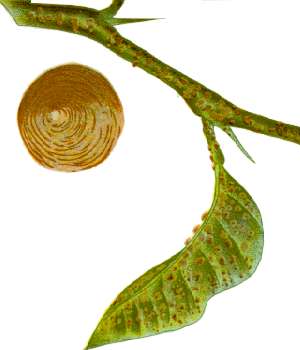
Diaspidinae is the largest subfamily of Diaspididae, with more than 200 genera in two tribes.

Aspidiotinae is a large subfamily of armored scale insects, with approximately 169 genera.

Aulacaspis, is a scale insect genus in the family Diaspididae. The type species is Aulacaspis rosae.

Ancepaspidinae is a subfamily of armored scale insects in the family Diaspididae. They are found mainly in the New World, although the insects are highly invasive and occur elsewhere.

Aspidiotini is a tribe in the armored scale insect family Diaspididae. They are found worldwide.
Leucaspidini is a tribe of armored scale insects.
Odonaspidini is a tribe in the armored scale insect family Diaspididae.

Parlatoriini is a tribe in the armored scale insect family Diaspididae. Takagi (2002) indicated that the Parlatoriini appear to be phylogenetically related to the Smilacicola and the Odonaspidini. Takagi went on to say about the tropical east Asian Parlatoriini that, The current classification of their genera may be largely tentative because the adult females are simple-featured and much modified owing to the pupillarial mode of life, and also because the second instar nymphs are generally similar among parlatoriines, whether the adult females are pupillarial or not. Andersen found that separating out pupillarial forms into a separate subtribe, Gymnaspidina, was counterproductive, as being non-dispositive.
Smilacicola is a genus in the armored scale insect family Diaspididae, the sole genus of the tribe Smilacicolini. There are at least three described species in Smilacicola, found in eastern Asia.

Diaspidini is a tribe in the armored scale insect family Diaspididae. The insects are highly invasive, and are significant economic pests found worldwide.

Lepidosaphidini is a tribe of armored scale insects.
Furcaspidina is a subtribe of armored scale insects, traditionally regarded as part of the Aspidiotini. While the subtribe Furcaspidina was not mentioned in Takagi's 2002 study, the Aspidiotini were not deemed as problematical as the Diaspidini and Lepidosaphidini. In 2006, Williams reduced the Furcaspidina to a single genus, with about twenty-eight species. Andersen in 2009 suggested that the Furcaspidina belonged in an expanded subfamily of Diaspidinae; however, additional analysis suggests that the furcaspids are better placed in a distinct, but laterally equivalent subfamily to the Diaspidinae, possibly together with the gymnaspids which Borchsenius placed in the Aspidiotinae subfamily.

Chionaspidina is a subtribe of armored scale insects established by Borchenius. But unlike many of the subtribes recognized by Borchenius, this one was found to be morphologically valid by Takagi. Similarly, in molecular analysis, Andersen et al. found a clade roughly corresponding to the subtribe Chionaspidina.
Diaspidina is a subtribe of armored scale insects. It occurs mostly in the Americas and Africa, with a few species in tropical Asia. In the Americas Pseudoparlatoria is the largest genus, with Diaspis second; in Africa Diaspis is the largest genus. The grouping identified by Balachowsky in 1954 as the subtribe Diaspidina, are now the tribe Diaspidini.

Fioriniina is a subtribe of armored scale insects in the family Diaspididae. They are found almost exclusively in the Old World.
Rugaspidiotina is an obsolete subtribe of armored scale insects. It was established by Balachowsky in 1949 to accept those Diaspidinae which had rugaspidiotine characteristics as exemplified by genus Rugaspidiotus MacGillivray, species Rugaspidiotus arizonicus, and was moved from the Odonaspidini to the Diaspidini by Borchsenius. It was raised to tribe status as Rugaspidiotini. However, close examination of species assigned to the Rugaspidiotini showed that the rugaspidiotine characteristics convergently evolved in different groups of diaspidids. Rugaspidiotini and Rugaspidiotina are now regarded as obsolete groupings.

Lepidosaphes is a genus of armored scale insects in the family Diaspididae. There are at least 150 described species in Lepidosaphes, found worldwide.
Clavaspis is a genus of armoured scales in the family Diaspididae. There are more than 20 described species in Clavaspis.
Gymnaspidini is a tribe in the armored scale insect family Diaspididae. They are found in the Neotropics.








